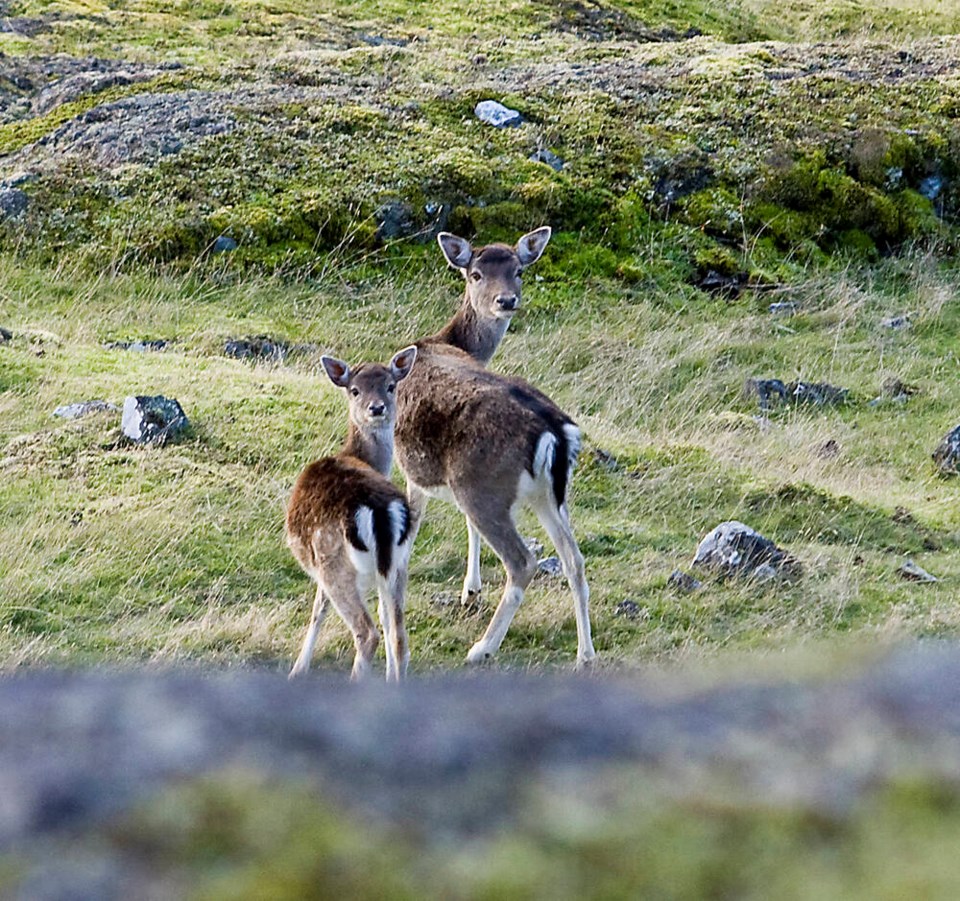The fallow deer of Sidney Island have been handed another reprieve.
A plan to eliminate fallow deer from the small island facing the town of Sidney was put on hold last month after a vote by the island’s property owners failed to meet the 75 per cent threshold to pass. Fifty-five per cent of the approximately 90 residents eligible to vote were in favour of the cull.
Some have since filed a claim with the Civil Resolution Tribunal to challenge the threshold level.
A number of different values are at play on the island regarding this issue. Some stakeholders favour the cull for ecological reasons.
Parks Canada, which manages about 180 hectares at the island’s north end and proposed the cull last year, says eradicating the invasive deer species is essential to restoring the island’s natural ecology and aiding the recovery of native plants that support insects, butterflies, songbirds, rodents and black-tailed deer.
Fallow deer, native to southern Europe, are opportunistic feeders — more so than the abundant native black-tailed deer that cause Vancouver Island gardeners so many headaches.
Fallow deer eat any plant available — herbs, shrubs, ferns, leaves, seedlings, branch tips and bark. They chew vegetation to the ground, prune and tip tree saplings into hedges — eventually killing them — and even uproot plants.
Trampling by the deer also disrupts the underlying soil ecology of forests, meadows and mixed woods.
As on other Gulf Islands where the invasive species has become established, fallow deer have dominated the local ecology on Sidney Island since their introduction decades ago. Even maintained at an estimated 300 to 500 individuals on the island, thanks to hunting and annual culls, the animals overbrowse native plants and undermine ecosystem-restoration efforts.
Under the island’s 2011 natural resources stewardship plan, developed and implemented by the Sallas Forest Strata Corp., which is made up of Sidney Island property owners, protection of the island’s natural environment is the strata’s “first priority.”
This is defined as “preserving the natural ecosystems in a healthy condition; maintaining the diversity of flora and fauna; and minimizing disturbances to these, and to the landscape, in pursuing owners’ other interests.”
Another of the plan’s guidelines is that “special effort should be made to protect rare and endangered species of plants and wildlife and, where practicable, to control invasive alien species.”
The question of reconciliation also applies. Sidney Island is part of the unceded territory of the Coast Salish First Nations. The deer’s ecological impacts have denied local First Nations access to medicine harvested from native plants on the island, even within the national park area.
Eric Pelkey, hereditary chief of the Tsawout Nation and representative of the WSÁNEĆ Leadership Council, told the Times Colonist last year that First Nations want to see the island returned to the natural state it was in before settlers arrived, when edible and medicinal plants such as camas and ferns were plentiful.
Other values are food security and food sourcing.
Indeed, hunting and annual culls have been key to controlling fallow deer numbers on the island to date. According to Parks Canada, some 11,300 deer were removed from the island through these management actions between 1981 and 2010, with hunting by residents and First Nations on the Parks Canada-controlled lands continuing every winter.
In a letter published in these pages a year ago, one Sidney Island resident wrote: “We have a vibrant hunting community and every year we get new hunters young and old joining us. If we eradicate our fallow deer, we will lose our hunting community and, within a decade, have a blacktail deer problem.”
Of course, if fallow deer were eradicated from the island and the province and the residents’ strata corporation were to allow hunting on the commonly held lands on the non-federal side of the island, any ensuing black-tailed deer problem presumably also could support a local hunting community — but without the ongoing detriment to natural ecosystems and native plants from the invasive, voracious fallow deer.
Which values prevail now depends on the province’s Civil Resolution Tribunal process. Until a tribunal hears and decides the challenge to the recent vote’s threshold level, the proposal to eradicate fallow deer from Sidney Island is on hold and the deer can carry on.



